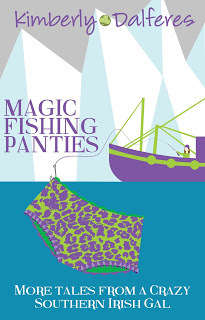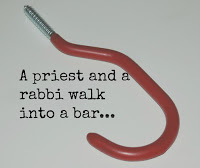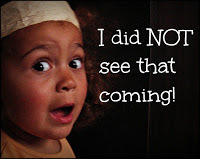A Priest & A Rabbi Walk Into a Bar...
 Today's guest blogger, Kimberly “Kimba” J. Dalferes, is a native Floridian who pretends to be a Virginian. Her accomplishments have included successfully threading a sewing bobbin, landing a 35 pound Alaskan king salmon, and scoring a ceramic sangria pitcher at an estate sale for $1. She also sometimes writes books. In fact, she allowed us to give you a sneak peek at her next book - The Magic Fishing Panties - right here! Her humor column–Dock Tale Hour–is featured in Laker Magazine. Today, Kimba tells us how to write humor her way.
Today's guest blogger, Kimberly “Kimba” J. Dalferes, is a native Floridian who pretends to be a Virginian. Her accomplishments have included successfully threading a sewing bobbin, landing a 35 pound Alaskan king salmon, and scoring a ceramic sangria pitcher at an estate sale for $1. She also sometimes writes books. In fact, she allowed us to give you a sneak peek at her next book - The Magic Fishing Panties - right here! Her humor column–Dock Tale Hour–is featured in Laker Magazine. Today, Kimba tells us how to write humor her way.I know it when I see it.Justice Potter Stewart, famously defining pornography
 Good humor writing is a lot like Justice Stewart’s porno. One gal’s laugh-fest is another woman’s offensive screed. I know a good joke when I hear one and I know a funny essay when I read it. However, sometimes it’s difficult to describe how to write good humor. But, here goes.
Good humor writing is a lot like Justice Stewart’s porno. One gal’s laugh-fest is another woman’s offensive screed. I know a good joke when I hear one and I know a funny essay when I read it. However, sometimes it’s difficult to describe how to write good humor. But, here goes.Key elements of good humor writing are not that dissimilar from good writing in general: show, don’t tell. “The clown slipped on the banana peel” is telling. More akin to showing would be: “JoJo, the sad-faced clown, never saw the yellow castoff strip of peel lying limp in the middle of the already wet pavement. In his haste to join his brethren in their tiny red clown car, JoJo perilously ignored a key principle of the clown playbook: slippery when wet.”
A well-written humorous story often evolves through three distinct phases: the hook; the set-up; and the punchline.
The Hook.

This statement–the hook– sets up the situation so the writer can now craft an engaging story. An effective hook has the reader pondering: Why are the priest and the rabbi together? What causes them to walk into a bar? What will happen to them in the bar?
The Set-up. The set-up often centers on an awkward situation, a ridiculous reaction, or a profound insight. In our example of our friends the priest and the rabbi, perhaps they are debating the use of Viagra, or why Viagra is blue, or how many Viagra pills it would take to screw in a light bulb. The set-up describes the bar, the conversation, and the back story leading up to the punchline.
 The Punchline. Every humorous story needs a punchline. This is the final element of the narrative intended to make the reader laugh, snort, or giggle. The build-up to the punchline can bring the reader along so that the story ending is obvious, yet satisfying. Or, a punchline can be unexpected, catching the reader off-guard and gleefully surprised.
The Punchline. Every humorous story needs a punchline. This is the final element of the narrative intended to make the reader laugh, snort, or giggle. The build-up to the punchline can bring the reader along so that the story ending is obvious, yet satisfying. Or, a punchline can be unexpected, catching the reader off-guard and gleefully surprised.One last suggestion: consider the “rule of three.” Like Goldilocks and the Three Bears or the Three Little Pigs, most stories seem to flow better, and are perceived as being funnier, when there are three discernible components. Taking this to heart, our hook should probably be changed to: A priest, a rabbi, and Hillary Clinton walk into a bar.
Gee, that is funnier.
Look for her new book, Magic Fishing Panties, to be released in August 2015 by Booktrope Publishing. She is often found hanging out on her blog The Middle-Aged Cheap Seats. You can also visit her at www.kimdalferes.com
Published on June 27, 2015 05:00
No comments have been added yet.



